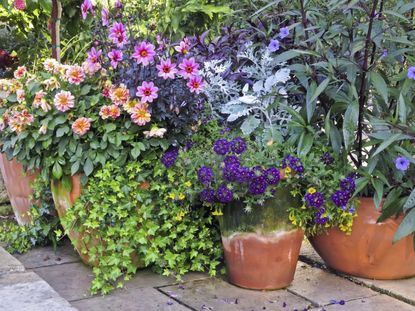Container Garden Arrangements: Container Gardening Ideas And More


Container gardens are a great idea if you don’t have the space for a traditional garden. Even if you do, they’re a good addition to a patio or along a walkway. They also make it easier to change your arrangements with the seasons, add the extra interest and color of containers, and raise plants up closer to eye level, making them more eye catching. Keep reading to learn how to plant a container garden.
Container Garden Arrangements
Container gardening ideas abound. Nothing says each container has to contain only one plant and, in fact, placing a few kinds of plants in the same container can make for a really attractive arrangement. A good mix involves three heights of plants: a single tall attention-grabbing variety surrounded by few shorter varieties to fill out the low space and add color and texture, with a hanging variety planted around the edges to drape over the side of the container – oftentimes referred to as the thriller, filler, spiller. When using multiple plants in the same container, it’s important to consider which direction it will be viewed from. Place your taller plants in the “back” of the container, with progressively shorter plants as you near the “front.” This is a good rule to consider for the overall look of your containers. Also, place smaller containers with smaller plants toward the front, where they can be seen. Make sure the plants you put in the same container have similar growing conditions and habits. This means pairing plants that have the same watering and sunlight requirements, and that are going to grow at the same rate. Otherwise, one plant may flourish while the others languish.
Additional Container Gardening How To
Cohesiveness is a big consideration in container garden arrangements. Try to include a uniting element, such as a recurring container or flower color. Similarly, container garden placement is important. Lots of mature plants arranged together run the risk of looking thrown together. Plant smaller plants in large, arranged containers to allow them to grow naturally into a cohesive scene.
Gardening tips, videos, info and more delivered right to your inbox!
Sign up for the Gardening Know How newsletter today and receive a free download of our most popular eBook "How to Grow Delicious Tomatoes."

The only child of a horticulturist and an English teacher, Liz Baessler was destined to become a gardening editor. She has been with Gardening Know how since 2015, and a Senior Editor since 2020. She holds a BA in English from Brandeis University and an MA in English from the University of Geneva, Switzerland. After years of gardening in containers and community garden plots, she finally has a backyard of her own, which she is systematically filling with vegetables and flowers.
-
 Want a Backyard Mini Orchard? Create Your Own Container Orchard
Want a Backyard Mini Orchard? Create Your Own Container OrchardEasier to care for in small spaces, a backyard mini-orchard makes sense for busy gardeners and juicy fruit is the reward.
By Teo Spengler
-
 Urban Beekeeping Guide: Top Tips For Raising Bees In The City
Urban Beekeeping Guide: Top Tips For Raising Bees In The CityUrban beekeeping can be a rewarding and appreciated pastime, but first be sure it’s legal in your city and learn the ropes of beekeeping.
By Mary Ellen Ellis